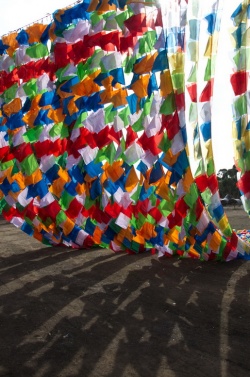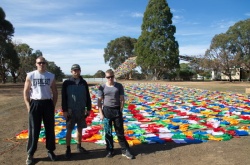History & Traditions of Prayer Flags
Associated with Tibetan Buddhism (see Tibet), these are coloured squares of cloth printed with mantras and images of Buddhist deities. They are attached to cords and hung up so that they may flutter in the wind. The movement is believed to ‘activate’ the power of the mantras and bestow protection and merit (puṇya).
The wind horse (longa) is the main symbol found on prayer flags. It is famed for its ability to run like the wind. On his back he carries the Three Jewels of Buddhism—the Buddha, dharma, and sangha. The Kalachakra seal is likened with Kalachakra meditation deity and is also associated with the Dalai Lama. The queen, the minister and the general are common symbols that are indispensable aids to the king.
"Wind is the natural element of the horse. As it gallops across the plain the wind arises to meet it, its long tail and mane flowing freely as it speeds through the stillness of the air, creating wind. Both the wind and the horse are natural vehicles of movement, the horse carrying material form and the wind ethereal form. Prayers are carried on the wind, and in Tibet the prayer flag is known as the Windhorse, Lung Ta, in Tibetan."
- from The Encyclopedia of Tibetan Symbols and Motifs by Robert Beer
Shambhala Press, 1999
Wood Carvers
Skilled wood block carvers, usually monks or lamas, carve prayer flag blocks as a spiritual practice. Squares of cloth, in each of the Five Elements/ Five Buddha Families' colors, are printed onto and sewn on a cord in groups of five. Usually the Windhorse is at the center with the Wishfulfilling Jewel on its back. On the corners are often the four supernatural creatures, Garuda, Dragon, Tiger and Snowlion. Sacred mantras accompany the images.
Flag Styles
There are two main styles of flags: horizontal (Lung Dar) or vertical (Dar Cho or Dar Chen). Images on the prayer flags may be of Buddhas, Bodhisattvas, Taras (Compassion), Rinpoches, animals, lotus, teachers, or a variety of important beings. The eight auspicious symbols that appear on many of the sets are the: Two Fish, Conch Shell, Parasol, Furled Banner, Wheel of Teaching that the Buddha turned, Eternal Knot, Lotus and the Treasure Vase of Sacred Water filled with the nectar of immortality.
Auspicious Occasions
The flags are raised to mark auspicious occasions, particularly at the New Year or Lo Sar, Tibetan New Year, which normally falls in mid February. In the year 2012, Lo Sar falls on February 22nd and brings forth the year of the Water Dragon. Prayer flags are believed to be activated by the wind that moves them. In this, they function somewhat in the nature of prayer wheels. It is common to write a person's name or the birth or wedding date of a person on one of the prayer flags to personalize it. As the wind carries the prayers off the cloth and into the heavens, the blessings are released to assist those who hang the flags and to benefit all beings.
In 800 C.E. (current era) Buddhism was first introduced to Tibet by Padmasambhava. Until that time most Tibetans followed the Bon religion, a shamanistic practice. Bon Shaman had been making and hanging flags in the five colors, representing the five elements, believing they would offer protection. As Buddhism blended with Bon, sacred mantras and iconographies were painted onto the Bon's flags, thus creating the beginnings of what are known today as Tibetan prayer flags. Atisha arrived to teach Buddhism to Tibetans in 1040 C.E. bringing with him the Indian Victory Banner and prayer flags gained more popularity. Tibetan prayer flags are a synthesis of the Bon's elemental flags and the Indian Buddhist's dharma.
There are two kinds of prayer flags, the horizontal ones called Lungta in Tibetan and the vertical ones called Darchor. Horizontal prayer flags are squares connected at the top edges with a long thread. The less used vertical prayer flags are usually single squares or groups of squares sewn on poles which are planted in the ground or on rooftops. Tibetans believe the prayers and mantras will be blown heavenward as offerings to their deities and will bring benefits to the one who hangs them, his neighborhood, and all sentient beings, even flying birds. However, if the flags are hung on the wrong astrological dates, they will bring only negative results. And the longer it hangs, the greater the obstacles which will arise. Old prayer flags are replaced with new ones annually on Tibetan New Year.
Prayer flags are gentle reminders, bringing us back to our essence and helping us to open our hearts and minds. When we hang prayer flags, we create the intention for more kindness for ourselves and all beings.
As they wave in the wind, prayer flags lift up and carry our wishes for compassion, peace and healing around the earth. Prayer flags encourage us to live more mindfully and help us to restore our own inner calm. A more peaceful world still must begin in each of us, one open heart at a time.
It is a sign of respect to keep them off of the ground or floor and to have clear, beneficial intentions as they are being hung. The cloth frays and the printed images fade as they are released to the wind and the heavens. When they are well worn they are often burned, to release the last expression of prayer. It is also common to see old, tattered flags side by side with new ones, left to the elements.


